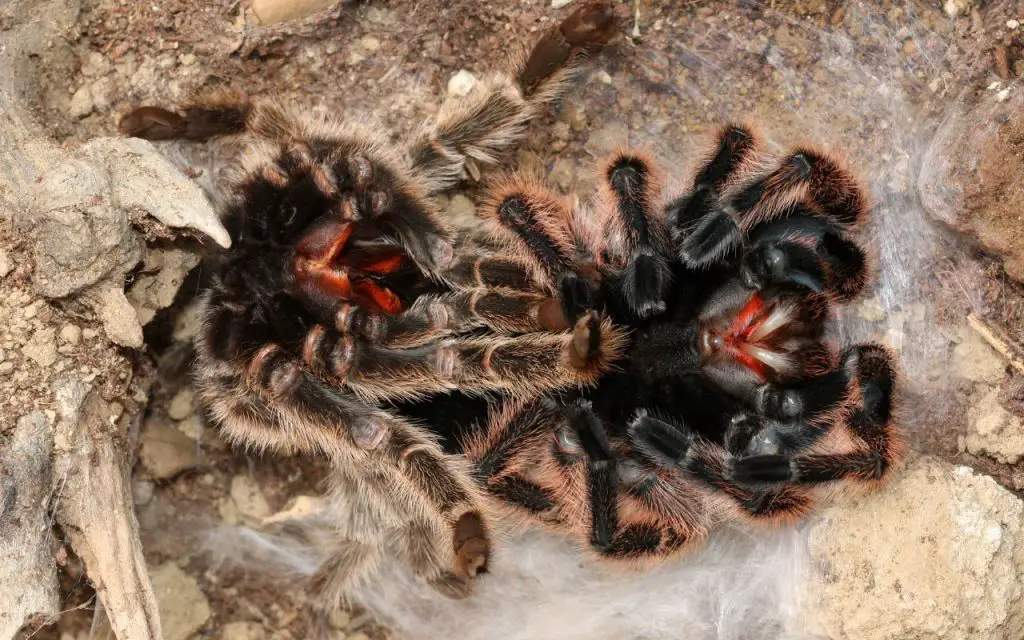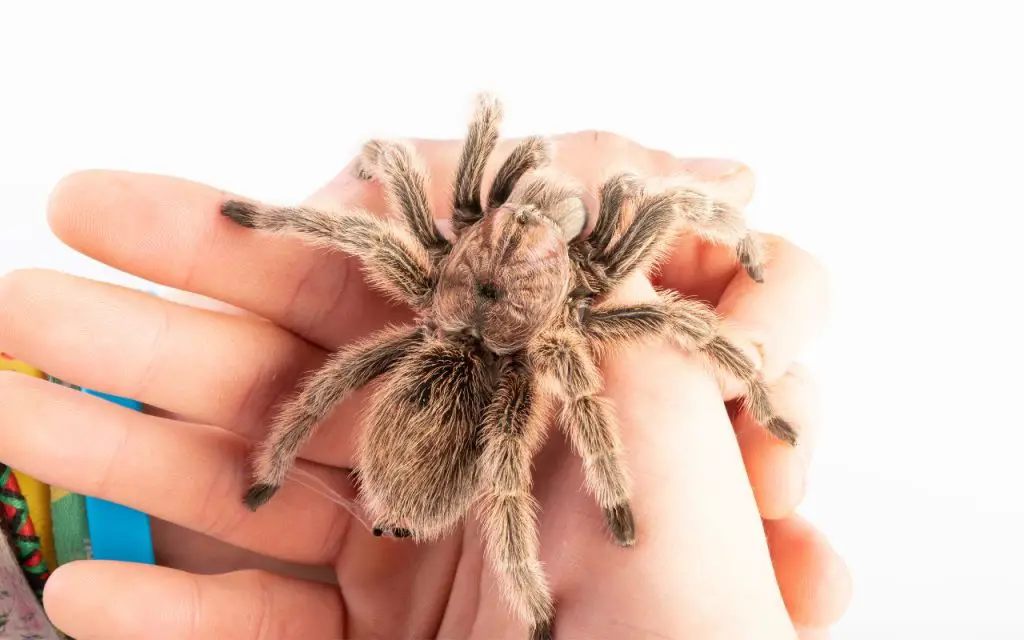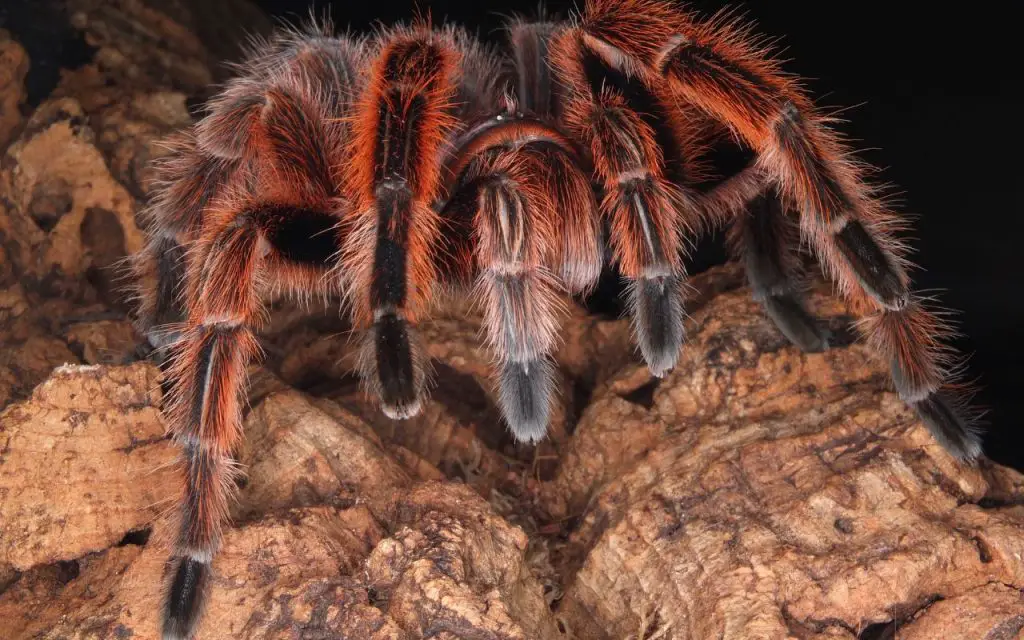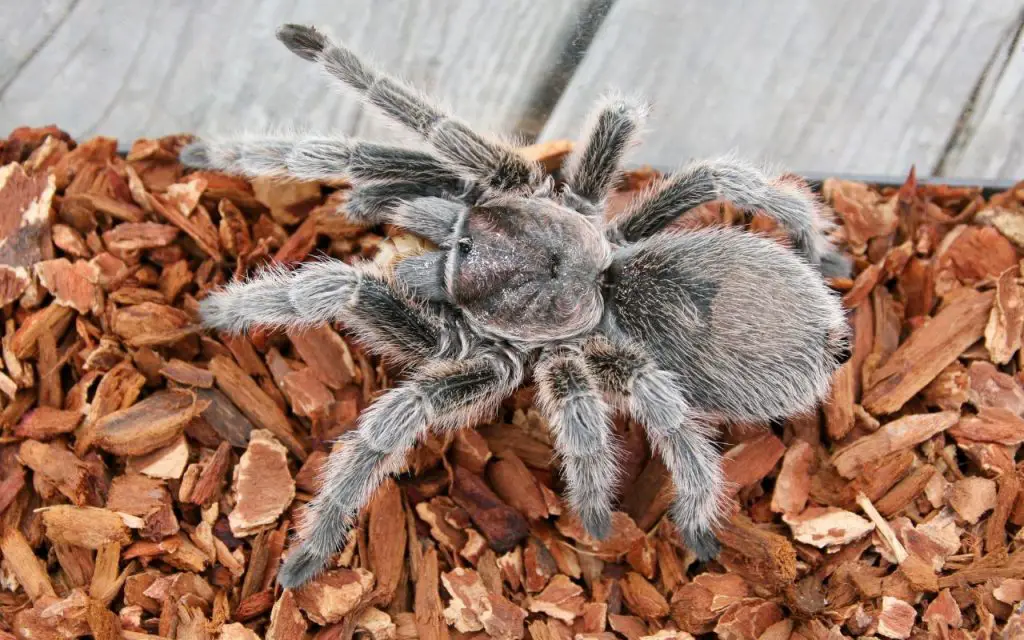Last updated on February 1st, 2023 at 09:54 am
Rose Hair tarantulas molt at varying frequency throughout their lives. When young they molt more often, then less and less as they grow…
Whilst young, Rose Tarantulas molt every few weeks, but adults will only molt once every few months at the most. Like many tarantulas, adult females may only molt once a year. Males, on the other hand, are much shorter lived, and only molt once after reaching full size at the age of four or five.
Chilean rose tarantula, also referred to as Chilean Fire Tarantula and Chilean Red Haired Tarantula is one of the most common species of tarantulas kept as pets.
They are natives to deserts and scrubland settings. These quiet and placid spiders derive their name from the pinkish tint of hairs on their backs.
In this article, we’ll take a look at how often they molt, but also how to care for them during the molting process.
Molting frequency in Rose Hair Tarantulas
Tarantulas molt multiple times before attaining adulthood. The number of molts varies among species and sex.
After reaching adulthood, male tarantulas stop molting, whereas females carry on doing so. For young tarantulas, the time between molts can range from a few weeks to a few months to several years.
Why did my tarantula died after molting?
There are instances where captive tarantulas pass away from molting. There are several potential explanations for this.
The spider being trapped inside the previous carapace is the most typical issue that arises during molting. Usually, only a little portion of the tarantula gets lodged, but on rare occasions, the tarantula can get stuck inside the old carapace resulting in a slow demise.
Poor molts are the main cause of death for large tarantulas. With the flimsy new exoskeleton, they practically have no support for a while after molting which can result in them crushed by their own weight.
Older species are simply too frail to successfully extricate themselves from their old exoskeleton.
Stress is another reason that molts may not succeed.
Insufficient internal hydration is typically the root of molting issues. You must be extremely careful not to disrupt a tarantula that is molting. Doing so could lead it to halt the process and become stuck.
Only if you notice your spider having noticeable difficulty removing themselves from the outer shell should you intervene during molting. The old shell and new skin can be separated by putting moisture on the location where they are trapped.
Inspecting tarantulas for death curls is another way to make sure they are not dying. Tarantulas that have recently molted frequently remain still for a long time as their exoskeleton hardens.
Give your tarantula at least 24 to 48 hours before declaring it a loss if you’re concerned that it passed away during its molt.

What happens if you touch a tarantula while its molting?
Touching your tarantula when it is molting puts them under stress, which could be quite harmful. A touch is an external stimulus that can halt a tarantula from molting or, if it has already begun, keep it trapped in the process.
It may also result in injuries as the newly generated exoskeleton will be in a fragile state. As a result, the tarantula might develop with malformations or perish during molting.
So, it is preferable that you do not disturb them either during or following their molt. If your tarantula is on its back, do not attempt to roll it over- this is totally natural and it will shift when it is ready.
The only time it is advised to disturb the cage is if you see a live feeder present with the tarantula that is intervening the process of molting.
How do you know when a tarantula is going to molt?
Tarantulas exhibit a variety of characteristics that indicate an upcoming molt.
- The tarantula ceasing to feed to prepare their bodies for the strenuous process is the most evident and frequent indicator. They go without food for lengthy durations, spanning from a few weeks to several months.
- Oftentimes, a tarantula that is about to molt may move much more slowly and sluggish than usual.
- Also occasionally seen on tarantulas’ abdomens is a bald patch that gets darker as the molting period approaches. The bald spot will disappear post molting.
Before it molts, the abdomen of tarantula might also seem darker and glossier than usual. You can also tell if Tarantula is about to molt by looking for visible fluid droplets, increased webbing, and dull coloration.

How do I know if my tarantula is happy?
A tarantula properly feeding and developing in its environment is an indicator of its satisfaction with the surroundings. Stress is indicated by a tarantula that continually roams its tank, seeks to escape, stops eating, and loses weight.
A hydrated, normal weight tarantula is neither overweight nor underweight. Its fangs will be cleaned, it will be spotless without blemishes, and most importantly, it will successfully molt.
Tarantula will frequently sit on the side glass if it is unhappy with the substrate it is on.
A tarantula is said to be at ease when his abdomen is level, his legs are slightly bowed but not tucked, and he is sitting on the ground. It feels at ease with his surroundings in this position.
However, even a slight disturbance has the power to disturb this tranquility.
How can I help my tarantula molt?
You can assist a tarantula molting by increasing the humidity in the container. Placing water to the water dish or spilling a small amount of water onto the substrate is all this needs, making it the least invasive and dangerous alternative.
However, avoid spilling anything on your tarantula’s book lungs. Discard the prey once the pre molt tarantula finishes feeding.
Check to see if there are any ants near the enclosure. Keep nourishing the tarantula one week after molting.
Some hobbyists could try to “cut” a tarantula out of its old exuvia- if you plan to do that, use only soft equipment. Using small, flat, soft implements, such as painters’ brushes, reduces the possibility of hurting tarantulas.
For delicately holding down your tarantula, use a wooden spatula or the base of the brushes.

How can I tell if my tarantula is dehydrated?
The most typical issue for tarantulas kept in unsuitable circumstances is dehydration. A shrunken abdomen and a body that seems “hunched” from a lack of coordination in the limbs and lifting the body off the ground are indications.
A tarantula may need to drink right away if it is dehydrated. Dehydration happens most frequently when the cage has grown too dry or the spider hasn’t eaten in a while.
A tarantula requires the fundamental form of first aid if it is dehydrated. This entails shifting tarantula to a small vessel with a moist paper substrate and anything under which she can lurk.
How long should I wait to feed my tarantula after a molt?
You shouldn’t feed your tarantula immediately following a molt. As a basic rule, you can feed the tarantula once it begins moving around.
A week or two may pass if it is not accepting food.
Your tarantula will be severely frail and ill-equipped to eat during the intensive process of molting. Due to this, there shouldn’t be any feeders present in the tank either during or right after your tarantula’s molt.
Prior to feeding your tarantula, the key requirement is for their fangs to harden. The post-molt tarantula should not be handled or touched until it begins to feed to prevent injury.

How long does it take a sling to molt?
It may require few weeks to a month for slings. Species in adulthood frequently go through pre molt for several months. The amount of food it had before the molt, the size, temperature, and other variables all play a role.
It shouldn’t take more than a few hours to make a little sling, though.
Why is my tarantula going bald?
A tarantula loses hair and starts to getting bald spot due to number of reasons. This can be when it is in stress, stimulation, or when molt is about to occur.
Stress may be brought on by handling or relocation, the presence of cage mates or other tiny predators, or a sense of vulnerability.

FAQ relating to how often Rose Hair Tarantulas molt
How long does it take a rose hair tarantula to molt?
One to three hours are needed to complete a tarantula’s molt. Most often, it takes place at night.
Once complete, the old molted skin will exactly resemble your spider.
How often does a tarantula molt?
The age of the tarantula is the most crucial component, although molting frequency is also influenced by a number of other elements as well.
The younger tarantulas typically molt more often than older ones. Old tarantulas may molt once every year or two once over ten years of age.
The young molt typically once every month, gaining size every time.
How often do pink toe tarantulas molt?
The tarantula removes its old exoskeleton during the process known as molting and arises in a new, bigger one.
Young pink toe tarantulas molt significantly more frequently, up to once every month and typically 5 to 6 times a year. This occurs so that they can continue to grow. This is a similar rate to the Rose Hair Tarantula, so caring for a pink toe isn’t any less risky where molting is concerned.
The older ones only molt once every year or two.
How many hours does a tarantula molt?
Typically, molting takes a whole day or as little as 15 minutes. By examining the molt, which tarantula has left behind as proof, you should be able to determine whether it was molting.
A molt should not last more than 12 hours. Anything after that indicates the tarantula requiring assistance.







